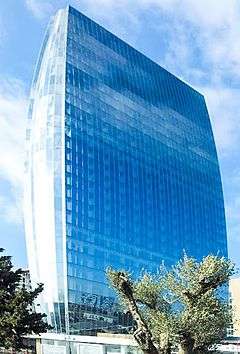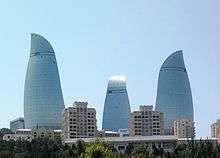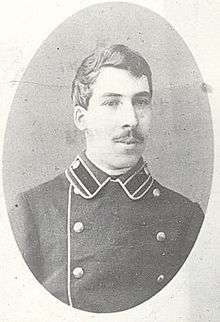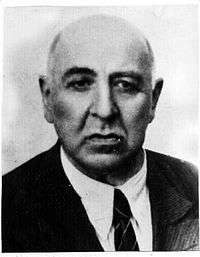Architecture of Baku

The architecture of Baku is not characterized by any particular architectural style, having accumulated its buildings over a long period of time.
In itself, Baku contains a wide variety of styles, progressing through Masud Ibn Davud's 12th century Maiden Tower and the educational institutions and buildings of the Russian Imperial era.
Late modern and postmodern architecture began to appear in the early-2000s. With the economic development, old buildings such as Atlant House have been razed to make way for new ones. Buildings with all glass shell appear around the city, with the most prominent examples being the SOCAR Tower and Flame Towers.
Several monuments pay homage to people and events in the city. The Martyrs' Lane provides views of the surrounding area whilst commemorating the victims of Black January and Nagorno-Karabakh War.[1][2]
Islamic
With Shi'a Islam being the dominant religion of Azerbaijan, there are may Islamic architecture featured buildings that resides in Baku. Religious places have more Islamic calligraphy drawn on the columns and other places on the structure.[3] In December 2000, the Old City of Baku, including the Palace of the Shirvanshahs and Maiden Tower, became the first location in Azerbaijan to be classified as a World Heritage Site by UNESCO.
-
Maiden Tower
-
.jpg)
Divankhane in the Palace of the Shirvanshahs
-
Mahammad Mosque with Minarat, located in Inner City of Baku
Islamic buildings continued to be constructed in Baku also during the Imperial period. In particular, the Ajdarbey Mosque in then outskirts of the city was built in 1912-1913.[4]
Russian Imperial and Azerbaijan Democratic Republic era
There are many buildings built in Baku at the turn of the 20th century that spot Victorian and Western influence in their designs. The city grew into one of the major industrial centres of Russian Empire as oil fields attracted Armenian, Russian and foreign investment.[5]
-
A classical late Russian Empire era buildings
-
House of Hajinsky
Soviet architecture
USSR Council of Ministers' resolution "On measures to further industrialization, improving quality and reducing the cost of construction" and "The removal of excess in the design and construction" in mid-50's has helped to initiate mass housing in Baku.[6]
The architectural image of the country's capital was enriched by a number of interesting in conception projects and highly significant in terms of urban sites, such as the building of the historical Ismailiyya building, which nowadays is the office of the Presidium of National Academy of Sciences of Azerbaijan, the Lenin Palace (now the Heydar Aliyev Palace), as well as marine and railway stations.[6]
-

An apartment building in the Stalinist architecture
Late Modernism and Post-Modern
Baku’s new business districts today has shifted around the Baku city center where many new and tall buildings with Late Modernism and Postmodern architecture. Aside from buildings used for business and institutions, various new residential developments are currently underway, many of which consist of high-rise buildings with a glass exterior, surrounded by American-style residential communities.
List of architects of Baku
The architects of Baku have influenced the city's architecture throughout its development during the 19th and 20th centuries.[7]
History
The names of numerous medieval architects of Baku are depicted on their buildings. One can mention the names of Masud ibn Davud, who designed Maiden Tower, his son Abdul-Majid Masud oglu, the author of the project of Sabayil Castle and Round Castle in Mardakan, Mahmud ibn Sa'ad, who built Bibi-Heybat Mosque, Nardaran Fortress and Mullah Ahmed mosque in Baku's Old City, etc.
Due to the oil boom in the 19th century, Baku became a rapidly developing city and grew rapidly.[8] The large-scale construction of the city was directly tied to the increase of the city's population. Eventually, this brought numerous Armenian, Azerbaijani, German (Adolf Eichler and Nicolaus von der Nonne), Polish (Józef Gosławski and Józef Plośko) and Russian architects to the city, who ultimately influenced the city's architectural profile.[8] Much of these architects were educated in Russia and, in particular, in St. Petersburg, Russia's capital city of the time. These included a number of high-profile designers, such as Freidun Aghalyan, Zivar bey Ahmadbeyov, Nikolai Bayev, Mammad Hasan Hajinski, and Hovhannes Katchaznouni.[9] From 1860 till 1868, Gasim bey Hajibababeyov was considered the chief architect of Baku.[10]
Architects during the Soviet period include Mikayil Huseynov, Sadig Dadashov, Lev Ilyin, Lev Rudnev etc.[11] In Baku also worked architects Hasan Majidov, who designed the building of Museum center, Talaat Khanlarov, the author of Heydar Aliyev Sports and Exhibition Complex,[12] Anvar Qasimzade, who designed the building of the Oil and Gas Research and Design Institute (1956) and Ulduz metro station.[13]
Architects
| Architect | Biography | Works |
|---|---|---|
| | Born Shusha, Karabakh November 20, 1876 – died Yerevan, Armenia SSR February 1, 1944. Of Armenian descent, in 1903 Aghalyan finished the St. Petersburg Institute of Civil Engineering. | In 1903–1921 he constructed railroad bridges, gymnasium, the Treasury palace and Workers House.[9][14] |
| Born Shamakhy, Azerbaijan 1873 - died 1925, Baku. In 1902, Zivar bey Ahmadbeyov graduated from Saint-Petersburg State University of Architecture and Civil Engineering. From this year to 1917, Ahmadbeyov worked as an architect in Baku Governorate, then in Baku City Council. After the establishment of the Azerbaijan Democratic Republic, Ahmadbeyov became the chief architect of Baku and held this post until 1922. | Two of the largest mosques in Baku, the Baku-Blue Mosque and Taza Pir Mosque were constructed (1905-1914) according to the projects of Ahmadbeyov.[15][16][17] Murtuza Mukhtarov Mosque, Saadet School (1912-1913), Ittifak Mosque (1911-1913), Hospital Pavilion, three houses on the yard of Mikhaylovskaya hospital (1912), corpus of Mikhaylovskaya hospital on Balakhanskaya 31 (1912-1913; now Fizuli Street), Children hospital on Persidskaya Street (1914-1918; now Mukhtarov Street), House on the 6th Park Lane 1 (1914-1916).[18] | |
| | Born Astrakhan, Russia October 6, 1875 – died August 5, 1952, Yerevan, Armenia SSR. Of Armenian descent, Bayev was educated at the St. Petersburg Institute of Civil Engineering. From 1911–1918 he worked as Major Engineer of Baku. | Constructed more than 100 buildings in Baku, including the Great Theatre of the Mayilyan Brothers (modern days Azerbaijan State Opera Theatre, 1911), Baku Northern Savings Bank, Sabunchi Railway Station (now the world's largest KFC), a neighborhood in the former Ermenikend area of Baku, series of schools, gymnasiums, Semashko Hospital (1914–18), residences of Salmanov, Sheremetiev, and others.[9][19][20][21][22][23][24][25] |
| Konstantin Borisoglebskiy | Born on October 16, 1861 in Moscow Gubernia. Graduated Peterburg University of Civil Engineering[26] | Olginskaya rows - four-stored building on Olginskaya Street 5 (now Rasulzade Street; 1910-1912), building of the Gymnasium on Balakhanskaya Street (now the building of hospital on Fizuli Street 61) built in 1913[18] |
 Mikhail Botov | Born 1855 - died 1886. Graduated Peterburg University of Civil Engineering in 1881.[18] | Mariinskaya Gymnasium (now the second building of the National Art Museum of Azerbaijan; 1883–85), Muslim bath (1884), Aleksandrovskaya baths (1884; not preserved), two one-storied houses (1883)[18] |
| Dmitriy Buynov | Born 1859. Graduated Peterburg University of Civil Engineering in 1884. He worked a long time in construction department of Baku Gubernia administration.[18] | Two-storied house (1888), the building of Saint Nina's School (now School №132 on Istiglaliyyat Street), the building of Real school (now the building of Azerbaijan State Economic University on Istiglaliyyat Street).[18] |
| Sadig Dadashov | Born on April 2 (15), 1905 in Baku. In 1929, he graduated from Azerbaijan State Oil Academy (afterwards he became its professor). He was the author of books about the architecture of Azerbaijan. He was a full member of the Academy of Sciences of the Azerbaijan SSR (1945). Sadiq Dadashov worked in close cooperation with M.A.Huseynov. He developed progressive traditions of Azerbaijani architecture creatively. Dadashov died in Moscow, on December 24, 1946. | He erected many residential and public buildings in Baku and in other cities of Azerbaijan. Cinema named after Nizami (1934), Nizami Museum of Azerbaijani Literature,[27] building of the Central Committee of the Communist Party of the Azerbaijan SSR (1938-1939), building of Baku Academy of Music are his famous projects. |
| Born November 8, 1869 — died 1911. He was a German civil architect. | Eichler is best known for building the Saviour's Church (at the age of 24) and participating in boulevard development, both in Baku. | |
| Born in Congress Poland to a noble Polish family. In 1891, he graduated from the Institute of Civil Engineering in Saint Petersburg, and a year later he was appointed chief architect of the city of Baku (present-day capital of Azerbaijan). His first task was to assist the local architect Robert Marfeld in designing and supervising the | Alexander Nevsky Cathedral, Taghiyev Residence (present-day Azerbaijan State Museum of History), the Empress Alexandra Russian Muslim Boarding School for Girls (present-day Fuzuli Institute of Manuscripts of the National Academy of Sciences of Azerbaijan), City Duma (present-day Baku City Hall), and a number of industrial buildings and houses. | |
| | Born in 1812, in Sarytorpaq village of Shamakhi. He got his primary education at mollah. His father and elder brother Semed bey also were architects. Gasim bey was the first among the Caucasians who worked in governmental and public organizations in the sphere of architecture and urban planning. From 1848, he worked as an assistant of a province architect of Shamakhi. In 1856, he became the architect of Shamakhi province. Since 1860 till 1868, he became the chief architect of Baku and from 1868 till the end of his life was the chief architect of Shamakhi. | Baku Boulevard – 1860-1861,[28] Tsitsianov square – 1860, Two-storeyed caravanserai – 1860’s (At present - Nizami Museum of Azerbaijani Literature), Two-storeyed caravanserai – 1870’s (Vorontsovskaya Street 1, now - Safarli Street), Residential houses in Krivaya street (now - Fountain Square) – 1870’s,[29] Building of "Araz" cinema,[30] Fountains square[31] |
| Hajinski was born on March 3, 1875. He graduated from Baku Realny School and then Peterburg Technical School in 1902 with an engineering degree. He worked at construction of a Russian oil refinery being built by Azerbaijani businessman Shamsi Asadullayev before he moved back to Azerbaijan and was appointed the director of construction department of Baku municipality. One of notable designers employed by Hajinski was Adolf Eichler | During the time Hajinski held the position of the director of construction department of Baku municipality, he made significant contributions to architectural improvements of Baku. Under his management, construction of Baku Seaside Boulevard gained a new impetus in 1910, when at his insistence, the Municipal Parliament passed a bill allocating 60,000 rubles for improvements. | |
| Mikayil Huseynov | Huseynov was born on 19 April 1905, in Baku, in a well-off family. His father was a millionaire, had streamships on the Caspian Sea and a great mansion on the seafront. His origination hang over him as the sword of Damocles and he could be arrested at any time. Until 1946, he worked in close creative and scientific cooperation with S.A. Dadashov. He died on October 7, 1992 and was buried in the Alley of Honor in Baku. | Building of the Central Committee of the Communist Party of Azerbaijan, Azerbaijan State Conservatory, Nizami Museum of Azerbaijan Literature in Baku, pavilion of All-Russia Exhibition Centre of Azerbaijan in Moscow (1939 and 1954), group of buildings of the Azerbaijan National Academy of Sciences (1951–1966) |
| Mashadi Mirza Gafar Ismayilov | Student of Hajibababayov. In 1868 – 1898 years he mainly did private practice. Prolific architect and a great graphic designers.[18] | House in Tazapirskaya Street (1885), two-storied house in Surakhanskaya Street (1886), two-storied house in Kolyubakinskaya Street (1887), two-storied house in Gubernskaya Street (1887), one-storied house in Persidskaya Street (1887), two-storied house in Tazapirskaya Street (1898), two-storied house in Nikolayevskaya Street (1890) etc.[18] |
 Anton Kandinov | ||
| |
Born 1868 Akhaltsikhe, Georgia – died Soviet Union 1938. Of Armenian descent, he graduated with honors from St. Petersburg Institute of Civil Engineering in 1893.[32] He eventually became the first Prime Minister of Armenia in 1918.[33] | Built a hospital, apartment houses, a hotel in Balakhany, and assisted in the construction of the Saint Thaddeus and Bartholomew Armenian Cathedral.[32] |
| Talat Khanlarov | Born 1927. Academician of Academy of Science of Azerbaijan, Honored Architect of Azerbaijan (1975), Vice-President of the International Academy of Architecture of the East.[12] | The building of Heydar Aliyev Sports and Exhibition Complex (with Tahir Abdullayev and Y. Qadimov), Imam Rza mosque in Sabunchi district, mosque in Narimanov district, the building of Memar Əcəmi metro station.[12] |
| Hasan Mejidov | The building of the Museum center. | |
 Nikolaus von der Nonne | Born 1836 — died 1906. He was a German civil architect. | Nikolaus von der Nonne is best known for building the first building of National Art Museum of Azerbaijan in Baku. |
| Józef Płoszko was born in 1867. He studied at the Russian Imperial Academy of Arts, but soon left it and joined the Petersburg University of Civil Engineers. After graduation in 1895, Plośko was sent to Kiev. Working there for two years, he moved to Baku at the invitation of another Polish architect Józef Goslawski and took place of local architect at construction department of the Baku city administration. He later became the chief architect of Baku. | Ismailiyya building, Catholic Polish church (kostel) in Baku, Catholic Church of Blessed Virgin Mary in Baku, the construction of which was finished in 1912, Palace of Happiness, Kerbalayi Israfil Hajiyev on Shemakhinskaya Street, building of Baku Puppet Theatre (1908), six-storeyed building of “New Europe” hotel on Qoncharovskaya Street (now Taghiyev Street), was the last work of Józef Plośko before the World War I. | |
| Anvar Qasimzade | Born 1912 – died 1969. Since 1967 he was corresponding member of Academy of Science of Azerbaijan | The building of Oil and Gas Research and Design Institute (1956), the building of Ulduz metro station |
| Alexander Rotinoff | Worked throughout the Caucasus. Of Armenian descent, in early 20th century, Alexander Rotinoff moved to Great Britain with his family and son – Mikhail Aleksander Rotinoff. Mikhail's son Gabriel Rotinoff founded Rotinoff Motors Ltd. at Colnbrook near Slough in 1952. | Together with Gavriil Ter-Mikelov he assisted in the construction of the Armenian church of Thadeus and Bartholomew in 1901.[34][35] |
| | Born Shusha, Karabakh March 8, 1875 – died Baku, Azerbaijan SSR March 29, 1955. Of Armenian descent, having graduated Realschule in Tbilisi, Sarkisov moved to St. Petersburg and entered the St. Petersburg Institute of Civil Engineering. In 1907 he moved to Baku and immediately received request for a series of projects. His architectural style was modern. Later on in his career, he switched to neoclassicism. Vartan Sarkisov died in Baku on March 29, 1955 and is buried in the Christian-Jewish Nariman Cemetery. In September 2007, the local Azerbaijani government ordered to destroy the Nariman Cemetery.[36] | Constructed the Oil Producers Sanatorium building in Mardakan (1930), a male gymnasium, Residence on Krasnovodskaya street (1908; today Torgovaya (Nizami) Street and Samad Vurghun Avenue intersection; this building is also where Lev Landau was born), reconstructed the Ismailiyya building which was burned during the March Days in 1918, residence of the Mirzabekov brothers in Nikolayevskaya street (1908), and the Residence of Tigran Melikov (Khagani Street, 27).[9][37][38] |
 Eugeniusz Skibiński | ||
| Martin Levon Tovmasyan | Born Martin Yerevan, Armenia SSR, March 5, 1925 – died Yerevan, Armenia 2008. Of Armenian descent, in 1949 he graduated from Azerbaijan Industrial Institute. He was a student of Vartan Sarkisov. He was awarded as Honored Architect of Armenia on May 28, 2007.[39] | Constructed the general layout of the Dyubendi village, 26 Commissars Metro Station (today Sahil station), Reception House and Hotel of Azerbaijan Council of Ministers, Green Theatre, and assisted in the construction of the Lenin Palace (Today Heydar Aliyev Palace).[9][40] |
| | Born Stavropol, Russia April 16, 1874 – died Tbilisi, Georgia SSR January 14, 1949. Of Armenian descent, in 1893 he studied at the St. Petersburg Institute of Civil Engineering. He graduated the institute in 1899. He moved to Baku where he lived and worked till 1912. He died January 14, 1949 and is buried in the Armenian Vera Cemetery in Tbilisi. | Designed Baku Public Club Building (today Azerbaijan State Philharmonic Hall), the maternity hospital (1899), the building of the Baku branch of the Tiflis Trade Bank (1902–1903; today “Children's World” department store), the Adamoff Brothers residence, the Sadikhov Residence (1910–1912; Nikolaev street house number 1; SSR number 21), Physiotherapy Institute, Four-storey Apartment ordered by Taghiyev (Nizam 30, crossroads with Mariinskaya Street), and the Commercial College (1905–1913; Merkurevskaya Street 39).[9][41][42][43][44][45][46] He was also one of the main architects of the Saint Thaddeus and Bartholomew Armenian Cathedral.[34] |
| Nikanor Tverdokhlebov |
Gallery
-
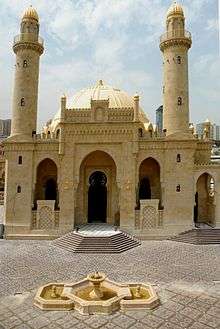
Taza Pir Mosque. Built by Zivar bey Ahmadbeyov (1905-1908)
-

Ajdarbey Mosque. Built by Zivar bey Ahmadbeyov (1912-1913)
-

Parapet Square designed by Gasim bey Hajibababeyov
-

Two-storeyed caravanserai. Built by Gasim bey Hajibababeyov
-

Azerbaijan State Philharmonic Hall constructed by Gavriil Ter-Mikelov.
-
Sadikhov Residence in Baku (1910–1912) designed by Gavriil Ter-Mikelov.
-

Physiotherapy Institute of Baku designed by Gavriil Ter-Mikelov (1929)
-
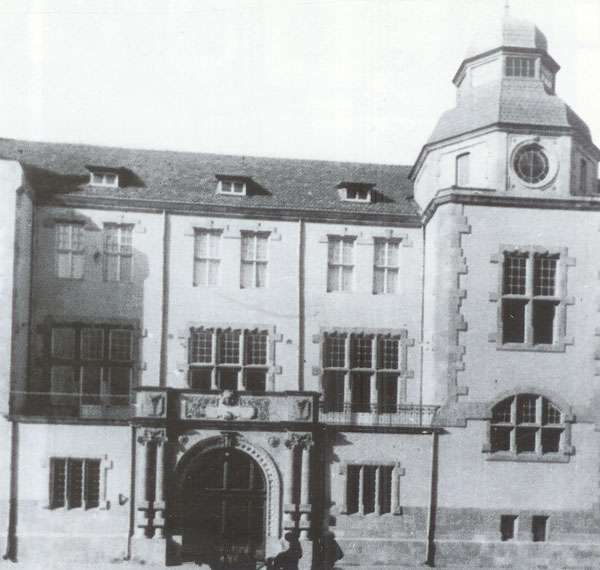
Commercial College of Baku designed by Gavriil Ter-Mikelov (1913)
-

The dwelling house of Adamyan brothers (1908) in Baratinskaya street designed by Gavriil Ter-Mikelov.
-

Baku Commercial Bank (1901) designed by Gavriil Ter-Mikelov.
-
First building of the National Art Museum of Azerbaijan designed by Nikolaus von der Nonne.
-
Building of Hospital designed by Konstantin Borisoglebskiy.
-
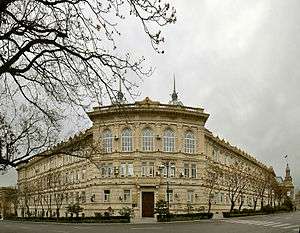
The main building of Azerbaijan State Economic University designed by Dmitriy Buynov.
-

The building of Saint Nina's school (now the building of the school №132) designed by Dmitriy Buynov.
-

The Building of the Union of Architects of Azerbaijan. Built in 1899 by Eugeniusz Skibiński.
-

Saint Thaddeus and Bartholomew Armenian Church constructed by Alexander Rotinyan, Gabriel Ter-Mikayelian, and Hovhannes Katchaznouni. Destroyed in the 1930s.
-

Azerbaijan State Opera Theatre (formerly known as The Great Theater of the Mayilyan Brothers) constructed by Nikolai Bayev (1910–11).
-
The house of Mirzabekov (Mirzabekyan) brothers on Nikolayevskaya street (today Istiglaliyyat Street), designed by Vartan Sarkisov
-

Sabunchi Railroad Station built by Nikolai Bayev (1927; today world's largest KFC).[1]
-

Ismailiyya building: Built in 1913 by Józef Plośko. Rebuilt by Vartan Sarkisov after a fire
-

Building of Baku Puppet Theatre. Built by Józef Plośko
-

The Church of the Blessed Virgin Mary's Immaculate Conception. Built by Józef Plośko
-

Heydar Aliyev Palace (formerly Lenin Palace) built by B. Ginsburg, E. Melkhisedekov and V. Shulgin[2][3] with the assistance of Armenian architects R. Torosyan, Martin Tovmasyan, and engineer A. Avanesov.[4]
-
Baku Municipality Hall. Built by Józef Gosławski
-

Building of Azerbaijan State Oil Academy. First two floors were built by Józef Gosławski
-
Building of National Museum of History of Azerbaijan. Built by Józef Gosławski
-

Building of Institute of Manuscripts of Azerbaijan. Built by Józef Gosławski
-
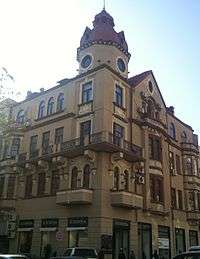
Residence on Krasnovodskaya street built by Vartan Sarkisov (1908).[5][6] Lev Landau lived in this house till 1924.
-
Hall of Baku Academy of Music. Designed by Mikayil Huseynov
-
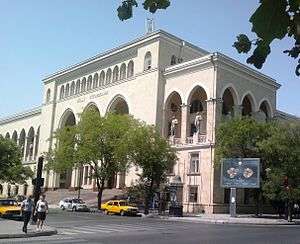
State Public Library named after M.F.Akhundov (1960). Designed by Mikayil Huseynov
- ^ Cite error: The named reference
World_Largest_KFCwas invoked but never defined (see the help page). - ^ Пашаев Н. А. Победа культурной революции в Советском Азербайджане. — М.: Наука, 1976. — С. 140. — 263 с.
- ^ Азербайджанская Советская Социалистическая Республика (Азербайджан) // Ежегодник Большой советской энциклопедии. — 1973. — С. 106.
- ^ "Armenian Buildings in Baku" (in Russian). Retrieved 4 December 2012.
Translated from Russian: The Lenin palace (now Heydar Aliyev Palace), architects – E. Melikhsedekov, R. Torosyan, M. Tovmasyan, A. Avanesov, engineer – K. Kalantar
- ^ Cite error: The named reference
Activity_of_Armenian_Architects_in_South_Caucasuswas invoked but never defined (see the help page). - ^ "Vardan Sargsyan". Orientica.net. Retrieved 4 December 2012.
Current developments
As a developing city largely influenced by economic oil boom, there are many construction projects that are currently being built that will change the city's skyline in the near future. Some of the construction project are SOCAR Tower, Crescent Bay Hotel, Baku White City, Baku National Stadium, Full Moon Hotel, Baku Hilton Hotel, and the Four Seasons Hotel.[47][48] A lot of the new development has come at the cost of old Soviet-era existing structures. The destruction of the Soviet heritage has created controversy, such as the recent destruction of the Soviet-era 26 Commissars Memorial in 2009 to make way for a new car park.[49][50]
In 2011, Discovery channel's Extreme Engineering program featured these projects that are under construction in Baku.[51]
Skyline
See also
References
- ↑ Baku: The tourist's-eye view of an oil-boom city
- ↑ Память об утратах и азербайджанское общество (Russian)
- ↑ Архитектура исламских мечетей (Russian)
- ↑ Фатуллаев-Фигаров, Шамиль Сейфулла оглы (1998). Архитектурная энциклопедия Баку. Baku: Международная Академия Архитектуры Стран Востока. p. 331.
- ↑ Ronald W. Ferrier, James H. Bamberg. The History of the British Petroleum Company: The Developing Years, 1901—1932. — Cambridge University Press, 1982 — Volume, p. 25 — ISBN 9780521246477
- 1 2 Архитектурное развитие города (Russian)
- ↑ Goltz, Thomas (1999). Azerbaijan diary : a rogue reporter's adventures in an oil-rich, war-torn, post-Soviet republic. Armonk, N.Y.: M.E. Sharpe. p. 16. ISBN 9780765602442.
- 1 2 Swietochowski, Tadeusz; Collins, Brian C. (1999). Historical dictionary of Azerbaijan. Lanham, Md.: Scarecrow. p. 19. ISBN 9780810835504.
- 1 2 3 4 5 6 Tigranyan, Edmond (2003). Activity of Armenian Architects in South Caucasus (in Armenian). Yerevan: Voskan Yerevantsi. p. 263. ISBN 9789993000525.
- ↑ Һаҹыбабабәјов Гасымбәј — Azerbaijan Soviet Encyclopedia, 1987. — V. 10. — P. 146.
- ↑ "Архитекторы Азербайджана (советский период)". Our Baku (in Russian). Retrieved 29 April 2014.
- 1 2 3 Эльтуран Авалов. Яркое творчество мастера. — Азербайджанские известия, 22 August 2007. — P. 3.
- ↑ "КАСИМЗАДЕ Энвер Али оглы (1912-69)". Большой энциклопедический словарь (in Russian). Retrieved 30 April 2014.
- ↑ Khudaverdyan, Konstantine (1990). Concise Armenian Encyclopedia (Volume I) (in Armenian). Yerevan. p. 121.
- ↑ "ДВЕ МЕЧЕТИ АРХИТЕКТОРА ЗИВЕРБЕКА АХМЕДБЕКОВА". odlar-yurdu.ru. 2007-12-23.
- ↑ "TƏZƏPİR MƏSCİD KOMPLEKSİ ƏSASLI YENİDƏNQURMA VƏ GENİŞ TİKİNTİ İŞLƏRİNDƏN SONRA İSTİFADƏYƏ VERİLMİŞDİR". Azerbaijan.az. 2009-07-07.
- ↑ "Мечеть Тезе Пир".
- 1 2 3 4 5 6 7 8 "Архитекторы Азербайджана 19 и начала 20-го века". Our Baku (in Russian). Retrieved 29 April 2014.
- ↑ Khudaverdyan, Konstantine (1990). Concise Armenian Encyclopedia (Volume I) (in Armenian). Yerevan. pp. 446–447.
- ↑ Lahusen, edited by Thomas; Dobrenko, Evgeny (1997). Socialist realism without shores. Durham [N.C.]: Duke University Press. p. 97. ISBN 9780822319412.
- ↑ Фауллаев Ш. С. – Градостроительство и Архитектура Азербайджана в XIX – нач. XX века, Л., 1986, стр. 182
- ↑ "Nikolai Baev". Our Baku (in Russian). Retrieved 2 December 2012.
- ↑ Opera in Azerbaijan by Azer Rezayev. Azerbaijan International. #5.4. Winter 1997
- ↑ "The Largest KFC In The World Is In Baku". Global Food Mate. Retrieved 2 December 2012.
- ↑ "Hospital Semashko." (in Russian). Ourbaku. Retrieved 2 December 2012.
Translated from Russian: The hospital was built by the architect N.G.Baeva in 1914–1918.
- ↑ Е. В. Холодова. Борисоглебский
- ↑ "SÖZ MƏBƏDI".
- ↑ "Бакинскому бульвару -100 лет /ФОТО/". 1news.az. Archived from the original on 2010-12-04.
- ↑ "Гаджибабабеков Касым-бек - архитектор". Наш Баку.
- ↑ "Кинотеатр "Араз"- улица Азизбекова". Baku pages.
- ↑ "Парапет - Колюбакинская площадь - сад им. К. Маркса - площадь Фонтанов". Наш Баку.
- 1 2 "Hovhannes Katchaznouni". Our Baku (in Russian). Retrieved 2 December 2012.
- ↑ Shaw, Stanford J. (2008). The Ottoman Empire in World War I. Ankara: Turkish Historical Society. p. 862. ISBN 9789751618832.
- 1 2 Tigranyan, Edmond (2003). Activity of Armenian Architects in South Caucasus (in Armenian). Yerevan: Voskan Yerevantsi. p. 264. ISBN 9789993000525.
- ↑ Mesrop Vardapet, «Ararat», St. Echmiadzin, 1903
- ↑ "В Баку варварски уничтожается христианско-еврейское кладбище (Christian-Jewish Cemetery Destroyed in Baku)" (in Russian). 2007-09-14. Retrieved 2 December 2012.
- ↑ "House of Tigran Melikov (Melikyan)". Ourbaku (in Russian). Ourbaku. Retrieved 2 December 2012.
Translated from Russian: The three-story building at the Molokan № 27 (Khagani) was built in the early twentieth century (arh. V.S.Sarkisov Prof. Sarkisov, architect) and owned by a local millionaire Tigran Melikov. He also made the designs of the houses on the streets Krasnovodskaya and Nikolaev.
- ↑ "Architects of Azerbaijan 19th and early 20th century" (in Russian). Ourbaku. Retrieved 2 December 2012.
Translated from Russian: Residential – 1915 – st. Molokan, 23. This five-storey house – 1917 – Ul.Nikolaevskaya, 11. A three-storey house – 1913 – st. Krasnovodsk, 13
- ↑ "28 MAY DAY FIRST REPUBLIC" (in Russian). May 30, 2007. Retrieved 2 December 2012.
- ↑ АРХИТЕКТОР, краткий биографический справочник союза архитекторов Армении, Автор-составитель – Лия Сафарян, Ер., "Зангак-97"
- ↑ "Azerbaijan State Philharmonic Hall: Official Website". Azerbaijan State Philharmonic Hall. Retrieved 2 December 2012.
The Azerbaijan State Philharmonic Hall was constructed throughout 1910–1912 at the request of the city elite and designed by the architect Gavril Ter-Mikelov in the Italian Renaissance (exterior) and German Rococo (interior) styles.
- ↑ "House Brothers Sadikhov (Baku)" (in Russian). Ourbaku. Retrieved 2 December 2012.
Translated from Russian: The architecture of this building, designed by the civil engineer G.M. Termikelova
- ↑ Thomson, Jason (2005). In the shadow of Aliyev : travels in Azerbaijan. London: Bennett & Bloom. p. 70. ISBN 9781898948728.
- ↑ "The buildings of the historic center of Baku (W – W – E)" (in Russian). Ourbaku. Retrieved 2 December 2012.
Translated from Russian. Merkurevskaya Street 39: Commercial School building. Built in 1913. Architect G.M.Ter-Mikelov
- ↑ Ш.Фатуллаев-Фигаров. «Архитектурная энциклопедия Баку». Международная академия архитекутры стран Востока, Баку-Анкара. — И. «Козан Офсет», 1998 — стр. 242, 266—275, 305—374.
- ↑ Waal, Thomas de (2004). Black garden : Armenia and Azerbaijan through peace and war ([Online-Ausg.] ed.). New York: New York University Press. p. 103. ISBN 9780814719459.
- ↑ UAE's Arabtec bids on Azerbaijan deal, earnings due
- ↑ Baku White City. Coming soon...
- ↑ В Азербайджане против демонтажа мемориала 26 Бакинских комиссаров протестуют только левые (Russian)
- ↑ В Баку начался демонтаж памятника 26 бакинским комиссарам (Russian)
- ↑ "DISCOVERY SCIENCE CHANNEL TO AIR PROGRAM ON BAKU". Retrieved 25 April 2011.





